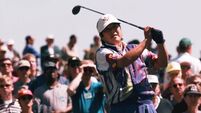PHIL CASEY: Nothing black and white with rule book
That the source of that assistance was golf’s rule book was something of a surprise, but it promises to be the gift that keeps on giving for the foreseeable future.
First in the spotlight was the pace of play, with Chinese schoolboy Guan Tianlang given a one-shot penalty in the second round which almost saw the 14-year-old miss the cut.
While that would have undoubtedly been harsh, there has been no suggestion that the rules were misapplied; putting it kindly, it was widely acknowledged that Guan was ‘deliberate’ to say the least.
However, what was hard to believe was that he was the only player guilty of slow play in a week that saw some rounds take almost six hours to complete.
The problem is that more experienced players know how to get round the current system, which requires their group to be out of position on the course, then to be timed and then to receive two ‘bad times’ before a penalty is assessed.
The slowest of players have developed a remarkable ability to resemble Usain Bolt when a referee looms on the horizon with stopwatch in hand, while one slow player in a group with two quick players can usually avoid detection in the first place.
Once the group is back in position and the referee required elsewhere, normal service is slowly resumed.
The next issue to arise was even more controversial, with the size of the penalty doubled and the fame of the guilty party exponentially bigger.
Tiger Woods was given a two-shot penalty for an incorrect drop during his second round, but only 15 hours after he had signed for an incorrect score.
Disqualification looked the only outcome given that Woods openly admitted he had dropped his ball in the wrong place on the 15th, but this time the rules came to his rescue. Or rather the interpretation of the rules did. Under rule 33-7, Woods was given a two-shot penalty but not disqualified, with the tournament rules committee effectively taking the blame for failing to spot the infringement when first alerted to it while Woods was still playing.
But under which part of rule 33-7 was he cleared?
The first line states that disqualification can be waived by the committee in “exceptional individual cases”. Perhaps it was more a case of a tournament not wishing to lose “an exceptional individual”.
Or was Woods cleared because of the revision to rule 33-7 in 2011 which “addresses the situation where a player is not aware he has breached a rule because of facts that he did not know and could not reasonably have discovered prior to returning his score card”?
Surely the world No 1 knows the rule about dropping his ball “as nearly as possible” to its original spot when taking a drop after hitting into a water hazard? And if he does not, when announcing the revision, the R&A and USGA confirmed that disqualification still applied for breaches that arise from “ignorance of the Rules of Golf”.
“It’s a shame that a player should leave for making a mistake in good faith, but according to the rules I thought I would play by myself,” said Spain’s Gonzalo Fernandez-Castano, who partnered Woods in the third round at Augusta. “I was surprised that he wasn’t disqualified. I didn’t know the rule they applied, but it’s there, and I respect the decision, though I’m not fully convinced that it was applicable in this case.”
And last but not least, Adam Scott’s victory completed the “long-putter Slam”, with all four Major championships — in fact four of the last six — having now been won by players using a belly or long putter.
Such ‘anchored’ putters are set to be banned from 2016 under proposals put forward by the R&A and USGA, but have unsurprisingly met with opposition from players who use them.
The most significant opposition has been from the PGA Tour and PGA of America, however, raising the possibility of different rules being applied at different events.
It is to be hoped that the game’s governing bodies hold their nerve and carry out the proposed ban, but whether it can be that simple remains to be seen.
And football referees think they have it tough.















